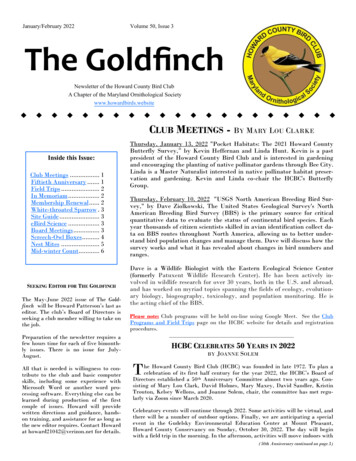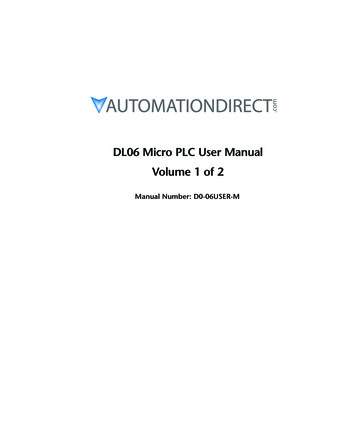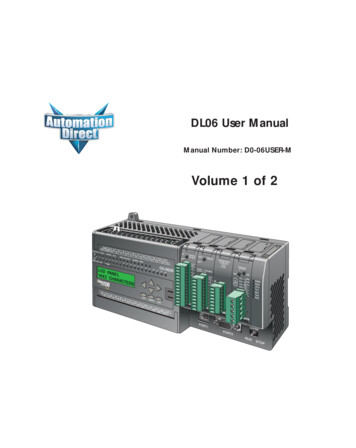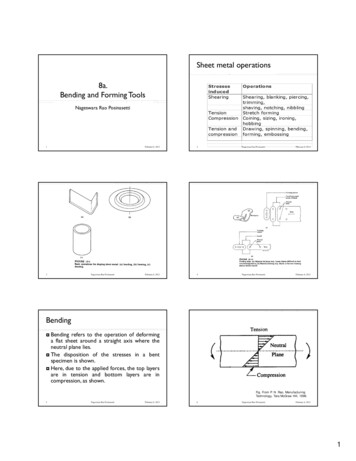
Transcription
Pacific Business Review InternationalVolume 8, Issue 8, February 2016Article SectionAn Application of Porter's Diamond Framework:A Case of Sports Goods Cluster at JalandharDr. Priya JhambAssistant Professor, Amity College of Commerce and Finance,Amity University, NoidaAbstractPorter (1990) in his book 'The Competitive Advantages of Nation' developed a diamond model in order to examine andinvestigate the reasons for the success of an industry in a specific region in comparison to the others. Porter found thatindustries rather than the nations are the one that compete and clusters have an important influence in improving thecompetitive advantage of the industry. The present study aims to apply Porter's diamond model to identify the sources ofcompetitive advantage of the cluster. The study is conducted on sports goods cluster of Jalandhar to understand the measuresfor improving its competitiveness. The study analyzes each of the four determinants of the diamond model to understandwhich determinant gives the competitive advantage to the cluster. The study proposes various strategies to create and upgradethe sustainable competitive advantage of sports goods cluster at Jalandhar.In order to fulfill the above objectives, the study is divided into three parts. First, a theoretical background of Porter's modeland sports goods cluster is identified. The use of Porter's model allows the author to identify the present status of the cluster byanalyzing the competitive advantage of the cluster with regard to each determinant and finally various suggestions forimproving the competitiveness are defined. The findings of the study will provide an insight for improving the competitivestructure of the clusters in developing countries like India.Keywords: Cluster, Competitive advantage, Diamond model.cluster at Jalandhar.IntroductionThe main objective of the research is to show the applicationof diamond model on a particular cluster and an extensiveanalysis of the model to frame various strategies for growthand up gradation of the cluster.Porter (1990) in his book 'The Competitive Advantage ofNations' has developed an interesting model named asDiamond Model with an aim to analyze and understand thereason for the success of certain industries in a specificnation in comparison to others. It was found that industriesrather than the nation are ones that compete and further,clusters play an important role in creating a competitiveadvantage for that of particular industry. Porter found thatcompetitive advantage is the result of interaction of fourdeterminants: factor conditions, demand conditions, relatedand supporting industries and firm structure, strategy andrivalry. Apart from these four factors, two other factors i.e.Government and Chance also affect this interaction. Porterdeveloped a model known as diamond model in order toillustrate the interaction between these factors.In order to fulfill the above objectives, the study is dividedinto three parts. First, a theoretical background of Porter'smodel and sports goods cluster is identified. The use ofPorter's model allows the author to identify the present statusof the cluster by analyzing the competitive advantage of thecluster with regard to each determinant and finally varioussuggestions for improving the competitiveness are defined.The findings of the study will provide an insight forimproving the competitive structure of the clusters indeveloping countries like India.Porters Diamond ModelThe present paper aims to apply Porter's model in Sportsgoods cluster at Jalandhar with the following objectives:Porter (1990) conducted a study of 10 nations to develop ananalytical framework in order to explain the reason whycertain firms based in particular nation were able to competeagainst foreign rivals in specific segments or industries insuccessful ways and also to gain an understanding on what isthe role of the nations economic environment, institutionand policies in the competitive success of its firms inparticular industries. The study was conducted mostly on1. To understand the actual situation of sports goodscluster at Jalandhar by analyzing each of the fourdeterminants and understand which determinantprovides competitive advantage to the cluster.2. Propose various strategies to create and upgrade thesustainable competitive advantage of sports goods141
Article SectionPacific Business Review InternationalDemand Conditions: Porter (1990) defined that the mostimportant characteristics that determines the demandconditions are 'the composition of the demand, its size andpatterns of the growth and the internalization of domesticdemand.' Porter emphasized more on demand in domesticmarket rather than demand in foreign market as firms areaware about domestic market more than foreign market andreact to there demand more quickly. The increase in thedemand of the firms' product motivates them to adopt newtechnology with less fear that all the facilities will beutilized. Porter (1990) defined that a nations firms gaincompetitive advantage if domestic buyers are sophisticatedand demanding as regards the product or service. Thesetypes of customers pressurize firms to innovate faster anddevelop new products or design. If the consumers are notdemanding, the firms will continue producing and supplyingsame products and will never think of producing anythingnew.developed nation's viz. Denmark, Germany, Italy, Japan,Sweden, Switzerland, United Kingdom and United Statesalong with Singapore and South Korea, two newlyindustrialized countries. More than 100 case studies wereconducted in these 10 nations and found that fourdeterminants of the home environment i.e. factor conditions,demand conditions, related and supporting industries andfirm structure, strategy and rivalry play an important role inproviding help to the domestic firms to attain and maintaincompetitive advantage. Porter also explained the role ofGovernment and Chance in influencing the functioning ofthese four determinants.Porter argued that it is not possible that a nation can becompetitive in all their industries, but it is the right mix ofthese determinants that allow some industries to have acompetitive advantage in the international environment.The various determinants of the diamond model are:Demand condition directly affects the performance of thecluster as firms start moving from producing low quality andimitative product or service to innovation and differentiation(Kakkainen, 2008). The pressure from demanding andsophisticated consumer motivates the firm to improve itsperformance with regard to existing as well as future needs.Porter explained that foreign market did not provide all thesebenefits but it is the local demand that makes the firmcompetitive. Porter (1998) explained that in the globaleconomy, the quality of local demand matters more than itssize and clusters in linked industries influence setting ofdemand conditions heavily.Factor Conditions: Factor conditions are the compulsoryinputs which are required by an organization to compete inthe market. These factors can be grouped into fivecategories: Human Resources, Physical Resources,Knowledge Resources, Capital Resources, InfrastructureResourcesThe competitiveness of the cluster is determined by theavailability of factors of production within the cluster. Thereis nothing more than the required inputs to compete in anyindustry (Karkkainen, 2008). The presence of sufficientresources ensures smooth working of the cluster. Porter(1990) explained that two types of factors are required by thefirms. These are basic factors and advanced factors. Basicfactors include national resources, location, capital,availability of raw material and labour. Advanced factorsinclude modern infrastructure and presence of highlyeducated personnel in the cluster. Porter (1990) explainedthat advanced factors are the most important for enhancingthe competitiveness of the cluster. These factors arenecessary for smooth operation of the firms and in turn thatof cluster. The unavailability or shortage of any factors ofproduction forces the firms for innovation. The presence ofadverse conditions such as scarcity of raw material, shortageof labour and unavailability of infrastructure leads to twosituations i.e. either the firms start using resourceseffectively or firms start developing new designs, methodsor products. But both these situations help in improving thecompetitiveness of the cluster.Related and Supporting Industries: The third determinanton Porter's model is the presence of related and supportingindustries. The presence of suppliers accelerates the processof innovation and upgrades the business of the cluster. Thepresence of related industries gives a better chance to thefirms located in the cluster to share information and identifynew opportunities.Firm Strategy, Structure and Rivalry: This factordetermines the ways; the firms are created, organized andmanaged. Porter explained that no managerial approach canbe considered the best for the development of an industryrather than it depends on the manner how efficiently thenations practice match the competitive advantage of aparticular nation. Porter explained that competition andrivalry within the cluster directly affects its competitiveness.The presence of competitors within the cluster leads toinnovation and continuous improvement (Porter, 1990).Before formulating any strategy, the firms always considerthe reaction of the competitor located at the same place. Thepresence of rivalry generates imitation. The presence oflarge number of competitors in the cluster motivates all theWith regard to factor condition, every region has its ownstrengths and weaknesses, but the competitiveness dependsupon the efficiency with which factors have been utilized.142
Article SectionPacific Business Review Internationalcenters for sports goods manufacture and the only industrywhich appears to offer some prospects is sports goodsindustry of Punjab. Meerut is yet to become powerful(Chandra Mohan, 2002).firms to take notice of each others' action and try to adopt thebest strategy to face the competition. As domestic firms arevisible to each other, success on the part of one showed thatfurther development is possible in the local circumstances(Davies and Ellis, 2000). The pressure from the firms whichare in proximity to each other provides inspiration to thefirms to search for innovation and in turn improve itscompetitiveness.Jalandhar has grown as the major centre of Indiansports goods industry. Meerut in Uttar Pradesh is the secondand Gurgaon in Haryana is the third largest cluster of sportsgoods manufacturing. (NPC, 2009, p.1).Chance: Porter (1990) defined certain events which arebeyond the control of firms as chance events. These eventsmay create forces that reshape the structure of an industryallowing the firms to improve its competitive position.Chance is the likelihood that the external events such asnatural disasters and war can affect or benefit a country or anindustry or cluster but these events are entirely beyond thecontrol of Government and managers within the industries.Result and DiscussionThe present study aims to use the Diamond model to analyzethe position of sports goods cluster at Jalandhar with regardto the availability of the drivers of the competitiveadvantage.Factor Conditions: Porter classified factors into fivecategories:Government: The final element for the growth of cluster isthe Government. The presence of responsive, effective andorganized public sector helps in building an efficient cluster.Porter (1990) explained that in order to increase the exportearnings and innovative capacity of a region, itsGovernment should interact to develop a sustainable arrayof internationally competitive industry clusters.Government, through its policies helps in creation of newclusters or strengthening the existing cluster. Governmentcan help the cluster to limit or eliminate barriers to thegrowth. Porter (1998) defined that both national and localGovernments have an important role in the promotion of acluster. Besides, creating the framework conditions, rulesfor competition and promoting entrepreneurial spirit,Government should actively engaged in and promote suchan approach.(a) Human Resources: The sports goods cluster ofJalandhar is using labour intensive methods. It has 5000highly skilled workers (DIC, Jalandhar). This numbercomprises of the workers which are employed in theregistered firms on permanent basis. Apart from this, thereare many workers who are employed in the units which arenot registered as well as household workers who areworking at home. As per the records of SGS, there are 10000workers in the cluster.It is found that the firms in cluster employ less than 10workers. The main reason behind it is to avoid the provisionsof The Factories Act, 1947. Further, due to the seasonaldemand of sports goods, the firms do not employ permanentworkers rather workers are appointed as per the demand.When the demand increases, job workers are appointed tofulfill that demand. Further, the presence of subcontractorsin the cluster assures the availability of products as soon asdemand arises.Porter concludes that the presence of the factors in anation allows a particular industry to succeed and expandtheir competitive advantage over a period of time.The Sports Goods Cluster at Jalandhar(b) Physical Resources: Jalandhar is found to be suitableplace for manufacturing sports items due to its location nearthe foothills of Himalayas which assured regular supply ofwood and further the presence of leather cluster assuredregular supply of leather. At Jalandhar, both the rawmaterials required are easily available.The origin of sports goods Industry of India can betraced back to Sialkot, Pakistan. In 1947, after partition, theentrepreneur belonging to one community decided to shiftfrom Sialkot. The workers belonging to that community alsomigrated along with the entrepreneurs. As per theresettlement plan of Government of India, initially thesemigrants settled in Batala but later on shifted from Batala toJalandhar. (UNIDO, 2001, p.3). At Jalandhar, the rawmaterial required was easily available. Some of the migrantsshifted to Meerut where also the raw material required wasavailable. Knowledge Resources: There is lack of knowledgeresources within the cluster. It is found that human resourcedevelopment activities are not present in the cluster. Most ofthe firms do not give training to their workers as they thinkthat the workers borne the skills from their forefathers andthere is no need to give training to them. There is absence ofany training institute in the cluster. It is found that theindustry associations have organized one or two trainingPunjab and Meerut have emerged as the leading143
Volume 8, Issue 8, February 2016Article Sectionthe firms in the cluster are family owned and they are eithersole proprietorship or partnership firms. The partners of thepartnership firms are either family members or friends. Ithelps the firms to take independent decisions and more risk.programs in the cluster where only active members of thecluster participate but non members do not want to send theirworkers for training.(d) Capital Resources: It is found that the cluster isoperating with its own funds and firms are not facing anyproblem with regard to availability of finance. It can be dueto the high rate of interest on loan but the main factorcontributing to lesser problem of finance is low fixed capitalbase of the majority of firms. As most of the operations of thefirms are skill based, the requirement of fixed capital is lowand the firms generally go for their own sources.It is found that in the Jalandhar cluster, rivalry is very strongbecause of the presence of large number of firms at aparticular place. The presence of large number ofcompetitors in the cluster motivates all the firms to takenotice of each other's action and try to adopt the best strategyto face the competition.Government: The Central Government and the PunjabGovernment have designed various policies for sports goodsindustry. It is found that most of the policies are to promotethe exports of the products but there is absence of any policyfor the promotion of sports goods cluster. As far as domesticmarket is concerned, it is found that only one policy isframed by Government of Punjab for the providingincentives to domestic players. It is observed that theexporters are satisfied with the incentives provided by theGovernment but domestic players are highly dissatisfiedwith the role of Government. UNIDO (2001) conducted astudy on sports goods cluster at Jalandhar and found thatGovernment had provided support to the exporters for thepromotion of exports but no support is provided to thedomestic market. It shows that even after expiry of ten years,no initiatives are taken by the Government for providingsupport to the enterprises dealing in the domestic market.(e) Infrastructure: In terms of infrastructure, there is goodroad and rail connectivity with all states and the countryensuring easy transportation of raw material and finishedproducts. Further the presence of airport of Amritsar (60kms) ensures import and export from abroad.Demand Conditions: The classification of demandconditions explained by Porter will be used to analyze thesports goods cluster of Jalandhar with regard todetermination of competitive advantage. The market ofsports goods can be divided into two parts i.e. domesticmarket and international market. The main buyers for thedomestic market are Government departments, localcustomers and educational institutions. The main customersfor the international market are foreign customers,Government department, firms and institutions of variouscountries like UK, Australia, USA, South Africa, France,Germany etc. (Annual reports, Sports Goods ExportPromotion Council, New Delhi).Various firms have reported that the Governmentannounces various policies but they are never implemented.For example, one per cent freight subsidy was declared bythe Government of Punjab but this subsidy has never beengiven to the firms. It is seen that some firms are even notaware about the policies issued by the Government. Variousinitiatives are required to be taken by the Government topromote the growth and development of the cluster.Related and Supporting Industries: The suppliers of rawmaterial and machinery are available within the cluster. Thesuppliers of raw material provide both natural as well as manmade material to the cluster. There are many units located inthe cluster providing raw material to the manufacturers.These raw material suppliers are located in the core clusterlocation i.e. Basti Nau and Basti Sheikh. It is found that rawmaterial suppliers do not provide any technical help to thefirms for innovation but are interested only in the sale oftheir product.Chance: It is found that chance events have been favourablefor the sports goods cluster of Jalandhar. The location of thecluster near foothills of Himalayas ensures regular supply ofwood, an important raw material for the cluster. Further,good rail and road connectivity ensures easy availability ofraw material and supply of finished goods to the targetmarket.Firm Strategy, Structure and Rivalry: The sports goodscluster of Jalandhar consists of micro and small enterprises.No medium and large scale firms are located within thecluster. All the firms in the cluster have been establishedsince independence of India. The business is carried out bythe next two or three generations of the founder. In thepresent study, it is found that many new firms apart frommigrants units are also part of the cluster. New entrepreneursare also a source of new ideas and their vision, style andfunctioning is different from the units which are old. Most ofThe application of Diamond model to sports goods clusterof Jalandhar can be shown as:144
Article SectionPacific Business Review Internationalproviding information to all the firms in cluster. Variousseminars and workshops should be organized by theGovernment to provide information about the policies andits benefits so that maximum firms can take advantage ofthese policies. The work of Government does not end withframing a policy but its implementation should also beensured. A separate department of Government should begiven the task of ensuring timely implementation of policy.This department should also take feedback of the policyfrom the firms in order to ensure that the policy has achievedthe objective for which it was framed. Further this feedbackshould be used as a point of reference before framing newpolicies or revising the existing policies. The Governmentshould also ensure that all the departments who are involvedin implementation of the policy should be timely informedso that there should be proper implementation of policies.An information center should be established by theGovernment under Cluster Development Programme whereall the latest information relating to technology, innovation,raw material should be available. This information shouldbe provided to each firm in the cluster so that they becomeaware of the latest innovations.A number of trade fairs and exhibitions are organized invarious parts of the world. Sports Goods Export PromotionCouncil is providing a help to various exporters for theparticipation in the sports fairs. But this support is providedBased on above analysis, the present study suggests variousstrategies to upgrade the competitive advantage of sportsgoods cluster of Jalandhar.Human Resource DevelopmentIt has been learnt that the cluster is facing the shortage ofskilled labour. Further most of the firms do not give trainingto their workers. As the need of the industry is to adaptmodern technology, workers are required to be trained forhandling the machines. Most of the firms in the cluster resistproviding training to the workers because they do not wantto bear the cost of training. The public sector in associationwith private sector should establish specialized traininginstitutes to cater the needs of the cluster.Promotion of Domestic ProductsWhile purchasing the sports equipments, various agencieslike Sports Authority of India, Central Government, StateGovernment etc, should give preference to Indian sportsequipments. All the tournaments which are held in Indiashould be required to purchase products of Indian brandsonly.Initiatives by the GovernmentIt is seen that many firms in the cluster are not aware aboutvarious policies which are framed for the sports industry.Interactions with industry associations, BusinessDevelopment Service providers can help the Government in145
Volume 8, Issue 8, February 2016Article SectionEickelpasch, Alexander, Lejpras, Anna and Stephan,Andreas. (2010). Locational and internal sources offirm competitive advantage: Applying Porter'sdiamond model at the firm level. JIBS WorkingPapers No. 2010-6, Jonkoping University.George, Galanos and Manasis, Giannis (2010). Analysis ofcompetitiveness of Greek's olive oil sector usingPorter's Diamond Model. Research journal ofInternational Studies, 16, 33-46.Karkkainen, Riku. (2008). Clustering and internationalcompetitiveness of information technology industryin the Saint Petersburg Area. Lappeenranta.Leech, Jennifer (2011). Analysis of the Guatemalan Jadecluster using Porter's Diamond from theCompetitive Advantages of Nations. OtagoManagement Graduate Review, 9, 45-69.Mohan, Chandra (2002). Punjab's Disturbing IndustrialScene II. The Tribune, September 25, 10.Moon, Chang, H., Rugman, Alan, M. and Verbeke, Alain(1998). A generalized double diamond approach tothe global competitiveness of Korea and Singapore.International Business Review, 7, 135-150.Oz, Ozlem (2002). Assessing Porter's framework fornational advantage: The case of Turkey. Journal ofBusiness Research. 55, 509-515.Porter, Michael E. (1990). The Competitive Advantage ofNations. 1st Edition, Palgrave, New York Press.Porter, Michael E. (1998). Clusters and the New Economiesof Competition. Harvard Business Review, 76(6),77-90.Porter, Michael E. (1998). On Competition. HarvardBusiness School Publishing, Boston,Massachusetts.Report of National Productivity Council (2009).Competitiveness of Indian Sports Goods Industry.Department of Industrial Policy and Promotion,Ministry of Commerce and Industry, New Delhi.Smit. A. J. (2010). The competitive advantage of nations: IsPorter's Diamond framework a new theory thatexplains the international competitiveness ofcountries?. Southern African Business Review,14(1), 105-130.UNIDO (2001). Diagnostic Study – SME – The SportsGoods Cluster, Jalandhar, Punjab. NewDelhi,UNIDO.Wickham, Mark (2005). Reconceptualising Porter'sdiamond for the Australian context. Journal of NewBusiness Ideas and Trends, 3(2), 40-48.to its registered members. But a number of micro enterprisesdo not participate in such exhibitions. The Governmentshould provide subsidy to these small scale concerns so thatthey can also participate in such trade fairs.It is seen that in the international tournaments allthose sports equipments are used which are certified byinternational federations. But fee for such certification isvery high which every firm is not able to pay. TheGovernment should provide subsidy in the cost incurred bythe firm to obtain the certificates.Setting up of Special Economic ZoneThe Jalandhar cluster should be declared as the SpecialEconomic Zone. Declaration of cluster as the SpecialEconomic Zone will help in promotion of exports. A largeinvestment from domestic as well as foreign market will beattracted. The infrastructure facilities can be easilydeveloped leading to up-gradation of existing technologyand easy adoption of innovations. A better infrastructure willattract new firms leading to creation of employmentopportunities.Establishment of Business Development Cell andResearch InstitutesA Business Development Cell should be established in thecluster where at least some full time professionals should beappointed. These professionals should work on collection oflatest information in the international market. The cell canbe funded under Sports Goods Export Promotion Council orCluster Development Scheme by Government of India.Various research institutes or universities should beestablished that can help the cluster in enhancement of theresearch activities. Apart this, the Department of Industries,Government of Punjab, should help the cluster in gettingassistance about the innovations from other researchinstitutes located outside the cluster.ConclusionAfter using Porter's model and analyzing the differentdeterminants of competitive advantage, we can concludethat sports goods cluster of Jalandhar is mainly dependent onfactor conditions i.e. availability of raw material and skilledlabour. Apart from it, the presence of sophisticatedcustomers, suppliers of machinery and competitors enhancethe growth of the cluster. The cluster has to focus ondeveloping specialized and advance factors in order toupgrade competitive advantage from basic factors ofproduction. Further, timely and effective implementation ofGovernment policies and strategies can help the cluster tobecome more competitive.ReferencesDavies, H. and Ellis, P., D. (2000). Porter's CompetitiveAdvantage of Nations: Time for a final judgment?.Journal of Management Studies, 37(8), 1189-1213.146
firm structure, strategy and rivalry play an important role in providing help to the domestic firms to attain and maintain competitive advantage. Porter also explained the role of Government and Chance in influencing the functioning of these four determinants. Porter











